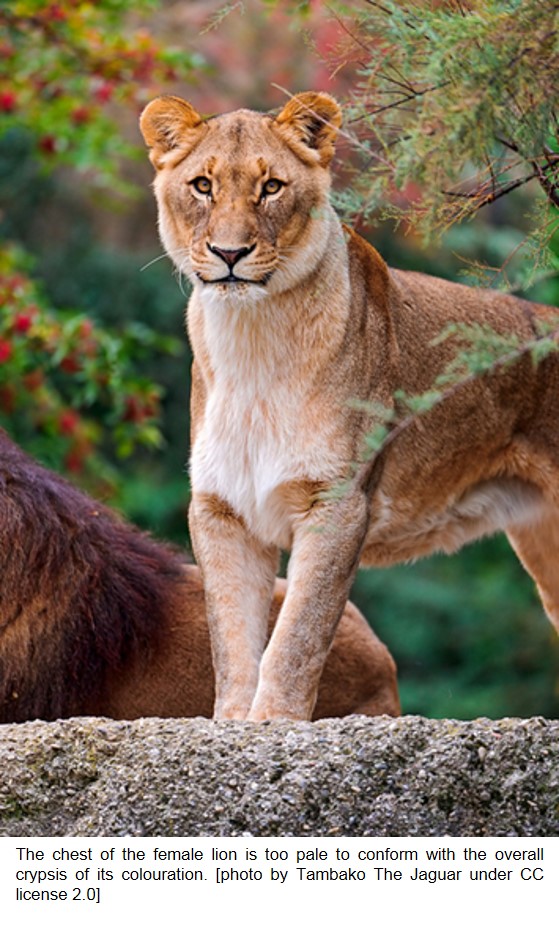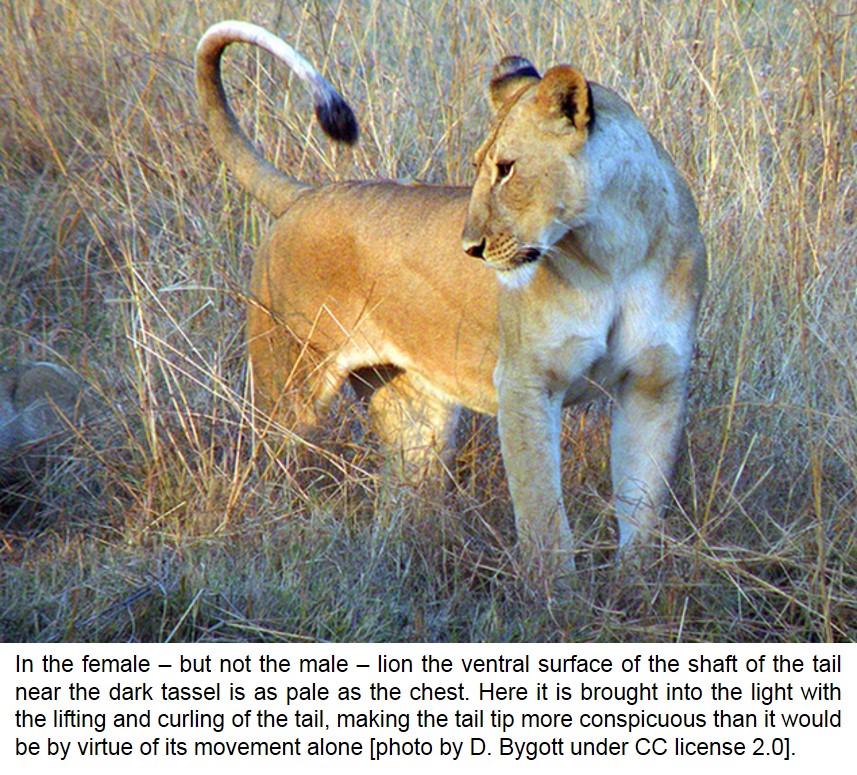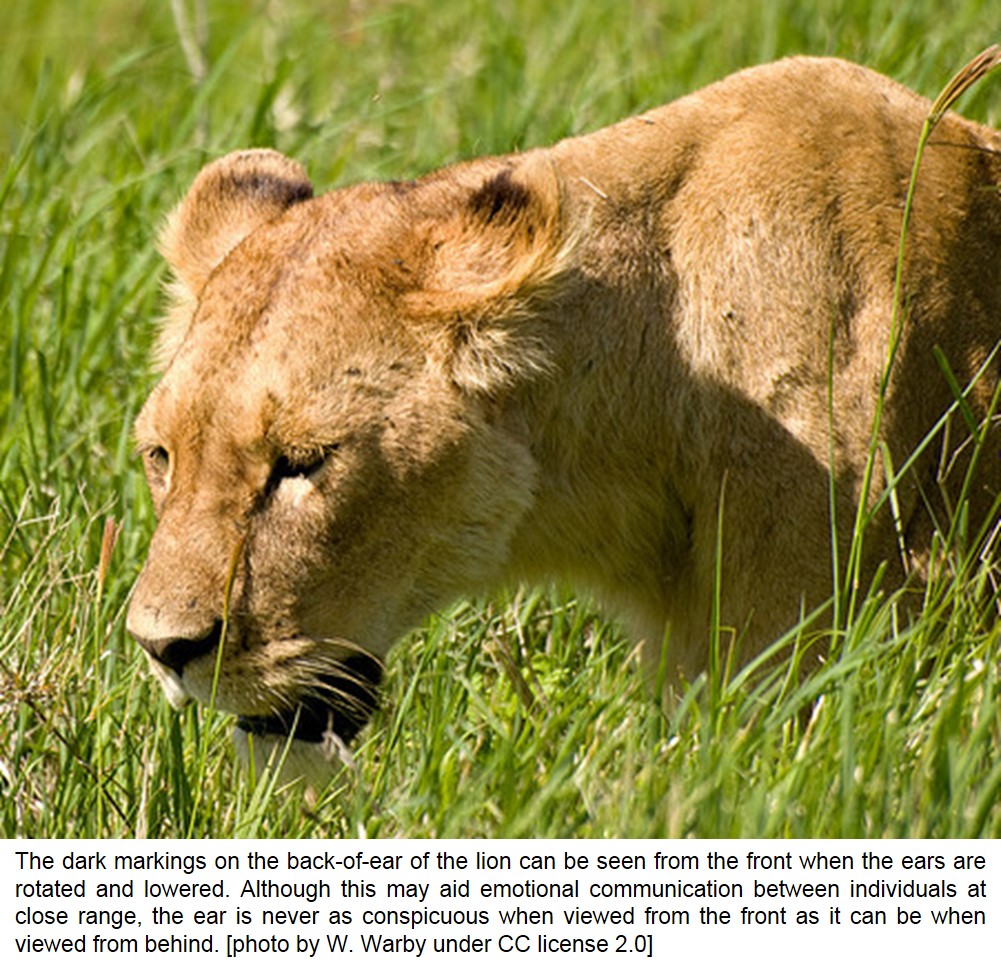Large felids are watchable, perhaps mesmerising.
And yet it has gradually dawned on us, during about three decades of watching the lion, watching biologists watch the lion, and watching the scientific literature on the lion: some obvious points about the appearance of this species keep on being missed by both expert and layperson.
This oversight seems remiss to us. There’s always at least one high-profile research team studying the lion in the field. Magazine editors are always keen on any new way to present big cats. Scientific and public appetite for material on the lion continually renews itself. We would have thought that a new angle self-evident from pictures – even without new stories – would have been scooped long ago. But instead it’s been left to us to make the discoveries below.
For more than 30 years we’ve snipped and pasted one of the most comprehensive photo-archives on the lion: an album of several thousand photos of this species from every printed source: magazines, travel brochures, newspapers, books, scientific papers. Along the way certain aspects of this species, dependent on posture and lighting, have dawned on us. There’s nothing particularly difficult here; as one gradually gets one’s eye in, the images seem to become more graphic.
We’ve eventually figured that if we don’t publish something about this nobody else will. This is a gift to Exploring the Bio-edge because most of these points could’ve been spotted even after a brief look at the lion, by anyone with the right search image and a bit of an artistic as well as biological eye.
So let’s take an anatomical tour of the lion with the following question in mind: ‘What role does colouration play in social interactions in this species?’
From the point of view of a tourist searching for the fawn predator in dry grass, the female lion has cryptic colouration. However, only the unobservant would describe her as plain, because several parts of the body break this model of crypsis. We start at the most dangerous end of the body.
The vicinity of the mouth of the female lion has whitish fur, too shiny to be explained by countershading. This paleness is offset by the black lips and gape, which are broadly exposed when the mouth is relaxed in a normal slack expression. The overall effect of tonal contrast makes her face conspicuous unless, as while stalking, she lowers her head.
Both male and female lion have this pattern of colouration in the vicinity of the mouth but they frame it differently. In the mature male, the whitish patch becomes part of the display of the whole maned head and neck. Although the male lion is well-known for his conspicuous front and the pale mouth is mere accentuation, the important point is that even the female, with her emphasis on crypsis, advertises her mouth in raised postures.
Focussing on the back of the head, we notice that both sexes of the lion have dark on the posterior surfaces of the ears despite the fact that the ear-fronts are the plainest of fawn in keeping with the general colouration of the body. However, the ears are more conspicuous in the female than in the male, for two reasons. Firstly, her ears are not covered by any mane. Secondly, when viewed from behind she presents a tonal contrast between the dark back-of-ear and a pale panel on the side of the neck which we describe below. Whereas the female lion has to sit up to display its mouth, the combination of back-of-ear and side-of-neck can be visible from behind even while the head is low during stalking.
Moving towards the ventral surface of the body: the female lion has a chest too pale to be explained simply as countershading. This whitish front is normally obscured but becomes obvious when she sits upright. With the combination of conspicuous mouth and conspicuous chest, the female lion can flag her front when she wishes to advertise herself. For his part, the male lacks any pale on the chest but can be equally conspicuous frontally in his full maturity. This is because the darkest part of his mane tends to be on his chest.
Now moving to the neck: the fawn panel on the side-of-neck is pale enough in the female lion, particularly in certain lights, that it can offset the dark markings on the backs of the ears. Although inconspicuous to the human eye, this pale panel seems to have a sheen effect. The male lacks this feature because the fawn side of his mane is neither pale nor dark.
Flipping to the posterior of the body: both sexes of the lion have a dark tassel on the tail. However, this is most conspicuous in the female for two reasons. Firstly, the tassel is both relatively and absolutely larger in the female than in the male. Secondly, the shaft of the tail closest to the tassel has a sheeny pale underside, which becomes lit up when the female raises and curls her tail. No such paleness is noticeable in the case of the male. The result is another tonal contrast in the female: the dark tassel with its pale punctuation. As in the case of the combination of dark back-of-ear and pale side-of-neck, this contrast can potentially be monitored from behind while the female lion is stalking, particularly if she twitches her tail while holding it low enough to be hidden from the prospective victim in front.
This anatomical tour shows us that however cryptic she may be, the female lion has markings distinct enough to be called ‘flags’. The function of these flags has yet to be studied in the field but they arguably aid social interactions in two ways important to the most gregarious of all cats.
The conspicuous front of the lion must be hidden during stalking, but at other times allows individuals to advertise their presence at a distance to members of the same species. This possibly functions in antagonism to conspecific intruders as part of the territorial behaviour of the species. Given that the lion roars more loudly than any other big cat, it makes sense that – at least in a sitting posture – it also makes itself visible[1] over hundreds of metres in bright light.
Unlike the mouth and chest, the tonal contrast between back-of-ear and side-of-neck is visible from obliquely behind. This suggests that it is used by members of the hunting group as they monitor each other’s positions during silent stalking.
An unconfirmed possibility is that the lion can see in the ultra-violet range and that the pale surfaces reflect extremely short wavelengths more than the range visible to humans. If so, it’s conceivable that the pale surfaces of these flags are brighter to the felid eye than to our eyes – particularly in dim illumination. Do any readers have access to ultraviolet-detecting equipment and a lion skin in the local museum? Please do post a photo in our comment stream of any pale surfaces of the fur taken in ultra-violet. We predict that this will show the lion, a bit like a scorpion[2], in something of a new light.





***
All text and images appearing in this blog are subject to copyright, except those images explicitly stated to be in the public domain. You are not free to use any photographs, for any purpose, without receiving written permission from the copyright holder.
1 The front of the lion is not particularly displayed during vocalisation because this species tends to roar with its head close to the ground.
2 The whole body of various species of scorpions reflects ultraviolet light. In the case of the lion, our hypothesis is that certain surfaces of fur may do likewise, particularly the pale fawn panel on the side of the neck.

